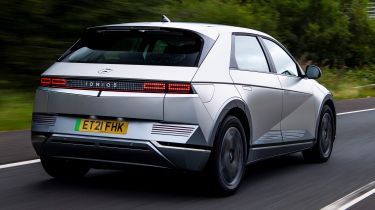Hyundai Ioniq 5 review: range, battery & charging
The Ioniq 5 isn't the outright class leader when it comes to range, but its rapid charging speeds are very impressive
| Model | Range | Wallbox charge time | Rapid charge time |
|---|---|---|---|
| 58kWh RWD | 240 miles | 9hrs 15mins (0-100%, 7.4kW) | 18mins (10-80%, 175kW) |
| 77kWh RWD | 315 miles | 11hrs 45mins (0-100%, 7.4kW) | 18mins (10-80%, 220kW) |
| 77kWh AWD | 298 miles | 11hrs 45mins (0-100%, 7.4kW) | 18mins (10-80%, 220kW) |
The longest-range variant of the Hyundai Ioniq 5 officially manages 315 miles on a single charge, which is a little short of what the Toyota bZ4X (319 miles), Nissan Ariya (329 miles) and Skoda Enyaq iV (339 miles) can manage when fully topped up.
The range-orientated versions of the Polestar 2 and Tesla Model 3 and Model Y also bests the Hyundai's figure. However, the Ioniq 5 fights back with rapid-charging capability that can only be beaten by the ultra-premium Audi e-tron GT and Porsche Taycan – and is arguably more important for everyday motoring.
What’s more, we’ve consistently found that Hyundai and Kia EVs can achieve their quoted range figures, and that the range estimate seems to go down at a rate you’d expect. As such, the Ioniq 5 is predictable and easy to live with. You may never suffer range anxiety.
Hyundai Ioniq 5 range
Two battery sizes and two different drivetrain configurations mean that maximum range varies depending on which variant you choose. The entry-level rear-drive car with the smaller 58kWh battery can hit 240 miles, while upgrading to the larger 77kWh battery boosts that number to just over 300 miles.
Going for the range-topping all-wheel-drive version (which uses the same 77kWh battery) doesn't get you the longest range, as its dual motors use more energy than single-motor rear-drive cars. This sees the official figure drop to 298 miles.
Hyundai increased the size of the larger battery in spring 2022, so cars built before this come with a 73kWh battery. That means the quoted range figures are slightly lower for these versions, with rear-drive cars managing exactly 300 miles and dual-motor cars achieving up to 287. The smaller battery remained unchanged.
We’ve tested the Ioniq 5 in multiple configurations at this point, and it has proved to be very efficient every time, returning on average between 3.4 and 3.5 miles per kWh. That equates to a real-world range of around 270 miles for a rear-drive Ioniq 5 with the larger 77kWh battery.
Charge time
The Ioniq 5s fitted with the 77kWh battery can recharge at up to 220kW – if you can find one of the ultra-rapid charging points capable of those speeds. They aren't all that common in the UK just yet, but if you can find one, you can replenish its battery from 10-80% capacity in just 18 minutes.
Not only is that double the charging speed of most current electric cars, including many of its rivals as we found when we pitted the Ioniq 5 against the Toyota bZ4X and Volkswagen ID.4; until now, it has been a feature reserved for more high-end models like the Audi e-tron GT, Mercedes EQS and Porsche Taycan. The smaller-battery model maxes out at 175kW, but the difference in the size of the battery pretty much cancels out the difference in charging speed.
From an 11kW home wallbox (which requires a three-phase electricity supply), you're looking at just over six hours to replenish the smaller battery, or just under eight to do the larger one. Most UK households can only support a 7.4kW wallbox, however: charging times in this instance will be over nine hours for the 58kWh car and just under 12 hours for the 77kWh models.
You’ll want a wallbox; charging off a conventional three-pin electricity socket is regarded as an ‘emergency’ option by Hyundai and it would take nearly 25 hours to recharge the smaller battery to 95%, and nearly 31 hours for the larger battery.
As part of the spring 2022 update, the Ioniq 5 now has a battery conditioning feature, enabling it to adapt its battery temperature while travelling to ensure optimal charging when a charging point is reached, particularly in colder or hotter temperatures. The function will activate automatically when a charging point is entered into the sat nav.

